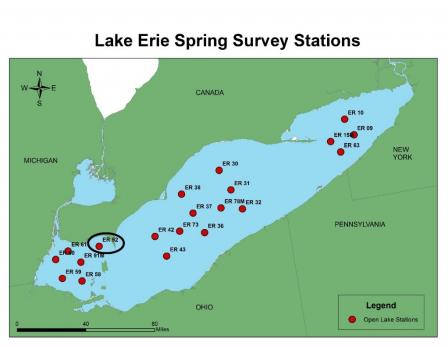Brachionus leydigii Frequently Asked Questions
On this page:
- What is Brachionus leydigii?
- Where was it found?
- Is this species invasive?
- What is significant about this detection?
- How are aquatic invasive species populations tracked?
- What does this mean for the Great Lakes?
- What is EPA doing about this species?
Q: What is Brachionus leydigii?
A: Brachionus leydigii is a rotifer, which is a type of small zooplankton. It is roughly 250 microns (0.25 mm) in length and nearly square in shape. B. leydigii is found across the globe, preferring cold water and filter feeding on small material such as bacteria and detritus.
There are approximately 275 species of rotifers already reported in the Great Lakes. From 2012-2014, 59 discrete rotifer species were detected in Lake Erie, 5 of them being the Brachionus species. This detection would be the 6th Brachionus species for Lake Erie.
A:  Brachionus leydigii found at the one circled Lake Erie Survey Station.EPA’s Great Lakes National Program Office and Cornell University recently confirmed the presence of B. leydigii during routine zooplankton monitoring in the open waters of Lake Erie as part of the GLNPO Long-term Biology Monitoring Program. On June 19, 2017, Cornell University researchers identified Brachionus leydigii among other zooplankton in a sample collected in the Spring of 2016 from station ER92 in the western basin of Lake Erie. The collected specimen, 1 individual female, was confirmed by recognized rotifer experts (Dr. Robert Wallace, Ripon College; Dr. Leszek Bledzki, Mount Holyoke College and Dr. Christian Jersabek, University of Salzburg). Ongoing analyses of samples collected in spring 2016 from other stations in the western basin of Lake Erie have not yielded any additional individuals.
Brachionus leydigii found at the one circled Lake Erie Survey Station.EPA’s Great Lakes National Program Office and Cornell University recently confirmed the presence of B. leydigii during routine zooplankton monitoring in the open waters of Lake Erie as part of the GLNPO Long-term Biology Monitoring Program. On June 19, 2017, Cornell University researchers identified Brachionus leydigii among other zooplankton in a sample collected in the Spring of 2016 from station ER92 in the western basin of Lake Erie. The collected specimen, 1 individual female, was confirmed by recognized rotifer experts (Dr. Robert Wallace, Ripon College; Dr. Leszek Bledzki, Mount Holyoke College and Dr. Christian Jersabek, University of Salzburg). Ongoing analyses of samples collected in spring 2016 from other stations in the western basin of Lake Erie have not yielded any additional individuals.
A: An invasive species is a non-native species that introduces harm, or is likely to harm, the environment, associated economies, or human health of an ecosystem. Brachionus leydigii is not native to the Great Lakes. The species has not been documented to cause harm, and has not been projected to cause harm in the Great Lakes. However, there is little information about this species, so additional scientific studies may be needed. Therefore, there isn’t enough information available yet to tell if B. leydigii is invasive.
There is little or no evidence to support B. leydigii has the potential for significant environmental or socio-economic impacts if introduced to the Great Lakes. There is also little to no evidence to support that B. leydigii has the potential for significant beneficial effects if introduced to the Great Lakes.
Q: What is significant about this detection?
A: This is significant because new discoveries of non-native species in the Great Lakes have been rare in the last 10 years. The bloody-red shrimp Hemimysis anomala was confirmed as established in the Great Lakes in 2006, the Grass Carp has been found to be reproducing in the Sandusky River, a tributary to Lake Erie, and more recently the invertebrate zooplankton Thermocyclops crassus was confirmed as established in the western basin of Lake Erie in 2016. The history of Great Lakes invasive species can be accessed through National Oceanic and Atmospheric Administration’s Great Lakes Aquatic Nonindigenous Species Information System (GLANSIS). As of 2017, over 180 aquatic non‐native species have become established in the Great Lakes basin. A species is considered established if it has a reproducing population within the basin, as inferred from multiple discoveries of adult and juvenile life stages over at least two consecutive years, so B. leydigii is not yet considered established.
B. leydigii has been identified in the NOAA’s Great Lakes Aquatic Nonindigenous Species Information System (GLANSIS) database as having high probability of introduction to the Great Lakes. The species was detected in the residual ballast sediments of 4 of 35 ships surveyed prior to entering the Great Lakes, indicating a potential shipping transport vector (Johengen et al. 2005).
Q: How are aquatic invasive species populations tracked?
A: The U.S. Geologic Survey Non-Indigenous Aquatic Species (NAS) database has location information for aquatic invasive species. The National Oceanic and Atmospheric Administration database links to the USGS database and provides other details.
Q: What does this mean for the Great Lakes
A: There is not enough information yet to know how this non-native species entered the Great lakes or how it will affect the Great Lakes ecosystems.
Q: What is EPA doing about this species?
A: EPA will continue to research this non-native species, monitor its abundance and distribution and assess any risk the species may pose to the ecosystem.
